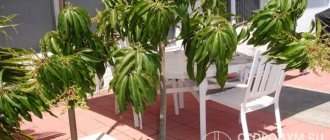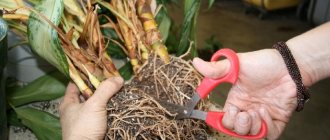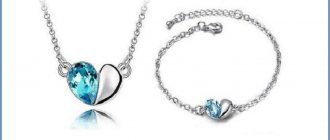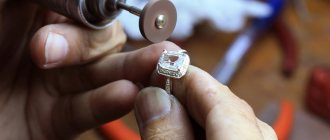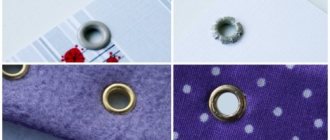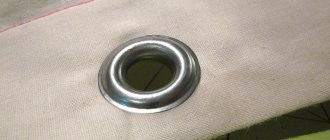Author: Elena N. https://floristics.info/ru/index.php?option=com_contact&view=contact&id=19 Category: Houseplants Published: February 28, 2019Last edits: January 11, 2021
- Propagation by cuttings
- Haworthia striped
The haworthia plant is represented by a number of bizarre and even fancy specimens. Some species resemble magical figurines, others resemble pebbles, others look like stalactites and stalagmites, others seem to be strewn with microscopic pearls, others fascinate with their iridescent colors... While admiring unusual plants, we rarely ask the question: why does it look this way? But Mother Nature had to work on the external appearance of Haworthias in truly extreme conditions. Just imagine: the African desert, the heat reaches 70°C, it rains very rarely, and if it does, most often its drops do not even touch the hot ground - they evaporate on the fly! Only special plants can survive in such conditions. Haworthia is one of them. That is why it is tiny (saves water), covered with tubercles and cilia (catches invaluable moisture), and its colored color (from blue to brown) protects haworthia from sunburn... How to help an exotic plant adapt to our conditions? Let's figure it out together.
Description of the plant, its origin
Haworthia is a small plant native to Africa. There are about 150 species and are classified as succulents.
Succulents are representatives of the plant world that have the ability to accumulate water reserves (for example, cacti, aloe).
In the wild, Haworthia grows on dry sandy or rocky slopes, preferring the shade of other, taller plants. The fleshy leaves form a rosette. Height is about 12 cm in an adult.
Haworthia, like all succulents, has the ability to store water in its fleshy tissues
The leaves are dense, fleshy, hard, rough, with growths; their appearance and surface depend on the variety (some have pronounced tubercles, others have almost inconspicuous tubercles). Some species have leaves with transparent zones through which light penetrates. Color: from dark to light green. The stem is absent or very short. Peduncle - up to 90 cm in length, flowers are small, not attracting attention, pinkish-white or greenish.
This is interesting! Haworthia received its name thanks to the scientist Adrian Haworth.
Some types of haworthia are similar to aloe. However, haworthia produces many children, while aloe does not. You can distinguish it as follows: on the underside of the leaf, haworthia has a clearly palpable edge, on the top there is roughness, while aloe has smooth and even leaves.
Externally, haworthia looks like aloe
At home, haworthia reproduces quickly and is unpretentious in care, but rarely blooms.
Popular species for home breeding - table
| View | Short description |
| Pearl | The leaves are fleshy, oval, pointed, dark green in color. The leaves have white speckles resembling pearls. |
| Striped | One of the most popular types. The leaves are dense, not very fleshy, there is a white pattern of growths on the underside of the leaf, the upper surface of the leaf is smooth. |
| Mosaic (chess) | A spiral arrangement of outwardly bent leaves with a pattern reminiscent of a chessboard. There is no stem. |
| Limofolia | The hard leaves, wide at the base, have a pattern in the form of stripes, as well as frequent transverse ribs. |
| Haworthia Reinwardt | The leaves in the rosette are thick, curved inward, the lower surface has bright white growths. |
| Big Band | The leaves are narrow, sharp, the upper side is dark green, the lower side is speckled with white. |
| Long-pointed | Dense and wide leaves are folded into a star-shaped rosette. The peculiarity of the variety is that the leaves have transparent areas. |
Striped, pearl, Big Band and other types of Haworthia - photo gallery
Pearly - small tubercles similar to pearls determine the name of the species
Limofolia leaves have frequent transverse ribs
The leaves of the elongated pointed haworthia have transparent areas
The pattern of the chess haworthia resembles a chess board
The Big Band species has elongated leaves
Haworthia rainwarda has a relatively long stem
Striped Haworthia is one of the most popular species
Kinds
Haworthia striped
A perennial without a trunk, consisting of dense basal rosettes with thick original lanceolate leaves with a white convex stripe on the lower surface, while the upper part of the leaves is smooth and green. The length of the leaves is up to 5 cm, width – a centimeter and a half.
In the photo: Haworthia limifolia variegata
Haworthia drawn
It is similar to the striped one, but not as attractive: instead of white convex stripes, it has only white and green convex dots on its leaves. The lanceolate leaves themselves are directed upward, their length is up to 7 cm, width up to one and a half centimeters.
In the photo: Haworthia maxima
Haworthia sinuous
Sometimes this succulent is called aloe tortuous: the plant has a short stem, up to 15 cm tall, dark green leaves 2.5 cm long, convex below, with small warts.
In the photo: Haworthia truncata
Haworthia adhesive
The plant is 10-20 cm tall, the leaves are small, oval, erect with bent tips, 2.5 cm long and up to 1.5 cm wide, arranged in three rows.
- Video about transplanting and propagating aichrizona
In the photo: Haworthia marumiana
Haworthia navicularis
Fleshy, shiny, boat-shaped leaves with windows on the surface are collected in a basal rosette, reaching a diameter of 10 cm, and if it has side shoots, then 15-20 cm.
In the photo: Haworthia glauca
Haworthia pearl
A herbaceous succulent perennial with an almost complete absence of a stem, forming a basal rosette of oval-pointed hard leaves 7-8 cm long and 2.5 cm wide. On both sides, the green leaves are covered with pearly white round bumps that look like pearls and give the plant a highly decorative appearance.
In the photo: Haworthia cooperi var. venusta
Haworthia chess
The leaves are thick, triangular in shape, jagged at the edges, collected in small rosettes. On the upper side of the leaves, light streaks form a net; the underside is covered with warts.
Pictured: Haworthia ex Japan
Haworthia Reinwardt
These triangular fleshy leaves, 3.5 cm long and 1-1.5 cm wide, form an elongated rosette. The underside of the leaves is covered with transverse and longitudinal rows of white bumps that stand out brightly against the very dark background of the leaf. The “zebrina” variety of this species has brighter warts, they are larger, and the plant looks very attractive. The erect stem of a young plant bends and falls over time.
Pictured: Haworthia daiginga
Haworthia retusa
Or Haworthia obtuse - has fleshy, hard triangular leaves, bent at the top, up to 5 cm long, covered with transparent windows and light strokes. Leaf color ranges from green to reddish-green or brownish-green. There are variegated and low-chlorophyll forms, and the “Giant” variety is distinguished by large leaves, the tops of which are dissected by veins.
In the photo: Haworthia limifolia striata
Haworthia diseases almost always occur due to violations of agricultural practices, so follow the rules of growing the plant, and you will never have trouble with it.
Photos taken from here
How to Create a Succulent Mix
Haworthia looks great in the company of other succulents. A wide glass container is suitable for the basis of an unusual garden. It needs to be disinfected and the bottom filled with a layer of drainage. Priming:
- garden and leaf soil;
- sand;
- activated carbon (protects against mold).
For decoration, you can add stones, artificial elements, etc. Carefully plant succulents in a pre-thought-out composition. Water lightly, then moisten the soil about once a month.
Succulents in an open florarium can become an unusual element of home decor
The soil
It is important that the soil drains water well and dries quickly. In this case, it is necessary that it be slightly alkaline or neutral. For Haworthia, a ready-made substrate for cacti and succulents , purchased in a store, is suitable.
Another way is to make the mixture yourself.
In this case, you can choose one of the options:
- Leaf and turf soil, sand - in a ratio of 2:2:1;
- Leafy, clay-turf soil, sand - in equal parts.
It is recommended to add a little brick chips to the haworthia mixture, which regulates soil moisture.
Instead of sand, you can use another baking powder. Good results are achieved by adding perlite or vermiculite to the soil mixture.
It’s good to add 1-2 handfuls of well-crushed charcoal to a bucket of ready-made soil mixture . This component protects the root system of the plant from rotting and inhibits the development of pathogenic fungi.
When planting a plant, it is necessary to place a drainage layer on the bottom of the pot. It is best to use small expanded clay or broken brick for this purpose.
Care
Watering
Haworthia needs moderate watering once a week in the summer season, once every 2-3 weeks in the winter. The signal for the next moistening is that the top layer of soil has dried out. Water should not get inside the socket.
Haworthia reacts to excess moisture by withering leaves; excess water can even lead to the death of the flower.
The succulent is absolutely indifferent to air humidity. Haworthia should not be sprayed, but you can occasionally wipe the dust on the leaves with a damp cloth.
Growing conditions at home - table
| Conditions | Recommendations |
| Location | Haworthia is a very heat-loving plant. Place it on the windowsill of a south-facing window. The flower loves airing. In summer, the plant can be taken outside and grown on a balcony, loggia, veranda or in open ground. In winter, it is advisable to place it above a heating radiator or place a piece of foam or felt under the pot to prevent the roots from overcooling. |
| Lighting | Intense light is very important for the growth and development of Haworthia. However, prolonged exposure to direct sunlight has a negative effect on the decorative appearance of the plant. In winter, it is necessary to illuminate with a fluorescent lamp. |
| Temperature | The most comfortable temperature for excellent growing of Haworthia is +23–27 ºС. But the flower feels quite well even at higher temperatures; it can withstand forty-degree heat without problems, but growth stops during this period. |
| Air and soil humidity | The humidity of both soil and air does not matter for Haworthia. The flower grows well in apartment conditions, without additional spraying. |
Diseases and pests of Haworthia
Haworthia is practically not susceptible to disease, but pests can cause damage to it.
Pest control measures - table
| Pests | How do they manifest themselves? | What to do |
| Aphid | A small insect that reproduces very quickly and feeds on plant sap. | Treatment with Aktara, Iskra Bio (according to instructions). Treatment is necessary for all plants in the house. |
| Spider mite | The appearance of a thin cobweb on the leaves. | Treatment with Iskra Bio, Agravertin, Neoron. 4 treatments with an interval of 1 week. |
| Mealybug | Sticky discharge on leaves. | Treatment with Aktara (according to instructions). 4 treatments at 10-day intervals. |
| Shchitovka | Small insects covered with shells suck the juice from the leaves. | |
| Thrips | A dark coating with a shiny sheen on the leaves. | Treatment with Fitoverm (according to instructions). |
Choosing a pot
Round ceramic pots with rough walls are best suited for growing exotic succulents, since it is very difficult for dried roots to cling to a smooth surface. And this creates a high probability of their rotting.
Also, you should not take containers that are too large, since the soil in them takes longer to dry out, which can cause overflow of the crop.
Reviews from flower growers
Haworthia is suitable for those who sometimes forget to water their flowers, because they come from arid countries and are able to retain water in the stem and leaves for a long time.
Beautiful, lush green, rough leaves captivated me with their beauty. On the kitchen windowsill, in an area of direct sunlight, the plant began to quickly wither, and the leaves began to rot and fall off. After transplanting it into another flower pot for cacti, I left it in the bathroom on the washing machine. And what do you think? Juicy greenery, new shoots simply filled the pot, I had to plant it out. Gardekja
https://otzovik.com/review_820753.html
I like it so much that I talk to it, it doesn’t bother me to care for it, it grows very slowly, anyone who grows it knows.
I heard that it can even bloom occasionally, but that didn’t surprise me. Clarice
https://irecommend.ru/content/vot-nichego-s-khavortiei-osobogo-ne-delayu-tolko-razgovarivayu-i-polivayu-ona-rastet-foto
A beautiful plant, completely unpretentious to care for.
Looks great on your desktop near your computer or on the windowsill. Beautiful living joy. Siderted
https://otzyv.expert/ekzotika-na-okne-1385279
Problems
With improper care and inappropriate conditions, the following problems may arise:
- Stretching and bending of the edges of the leaves, the color of the warty growths fades - the cause may be high temperatures in winter - above 15 degrees;
- The ends of the leaves dry out - too high a temperature and dry air;
- The lower leaves wither and tear off easily - excess moisture;
- The socket is pulled out - insufficient lighting;
- Redness or yellowing of leaves - excess mineral fertilizers;
- Blackening of leaves, rotting - very low temperature.
How to make a succulent garden - video
Haworthia turned out to be completely unpretentious in care. The variety of species will allow almost any gardener to choose a plant to their liking. And if you also create a mix of succulents, you can bring a unique charm to the interior of your apartment.
- Author: Diana Nikiforova
I never cease to be convinced that life is wonderful. Rate this article:
- 5
- 4
- 3
- 2
- 1
(3 votes, average: 4.3 out of 5)
Share with your friends!
Reproduction
The most suitable time for reproduction is spring. The main methods of propagation of Haworthia are propagation by lateral shoots and leaf cuttings.
Haworthia often has daughter rosettes that can be easily cut off with a knife . If such a shoot has its own roots, it is immediately planted in a separate pot. If there are no roots, the “baby” is dried for 3-4 days, and then sits in the sand for rooting. This method of reproduction is the easiest and fastest.
When propagating Haworthia by leaf, the leaf is carefully broken off from the mother plant. Then the cuttings are dried for 2-4 days and planted in sand.
Do not water the cuttings for 3-4 weeks after planting , but only lightly sprinkle the soil until roots appear. To avoid rotting, do not cover the container.
Composition of soil for succulents
A representative of the Xanthorrhoeae family does not tolerate acidic soil at all, which is why for cultivation it is better to choose a substrate with a weak or neutral reaction. The soil should not contain more than 50% organic matter. Otherwise, it will quickly acidify.
A mixture of pumice and lava particles, with a small amount of nutritious soil, is ideal. You can also make the mixture yourself from 3 parts peat, coconut fiber and sand, 1 part clay and 2 parts expanded clay.
The main advantages of Haworthia
If necessary, Haworthia can go without water for up to several weeks, without forcing you to rack your brains about who to entrust watering to during the holidays.
Thanks to this, it is an excellent idea for a gift that does not burden the recipient, because it is suitable for both home and office, and is able to endure long separations from a person without compromising its well-being.
In addition to being a very convenient houseplant, Haworthia boasts a huge number of different varieties. To all the other positive qualities of Haworthia, another bonus is that it is not poisonous to people or animals.
short biography
The Republic of South Africa is considered to be the birthplace of the plant. In this country, Haworthia grows in abundance in natural conditions. It was in South Africa that the succulent was found by an English botanist, in whose honor the flower got its name. These and other autobiographical details of the dwarf plant are indicated in the table.
Table - Biography of Haworthia in questions and answers
| Question | Answer |
| Genus | Succulents |
| Family | Asphodelaceae |
| Place of Birth | Africa, South Africa |
| Discoverer | Adrian Hardy Haworth (botanist) |
| Maximum height | 12 cm |
Blooming haworthia is a completely unattractive sight. The plant produces a long peduncle, on which an unsightly flower of gray-pink or light green color is formed. In their reviews, experienced flower growers recommend removing the peduncle immediately after detection. The need to take such emergency measures has a good reason: most succulents die after flowering, and it is no longer possible to revive them.
